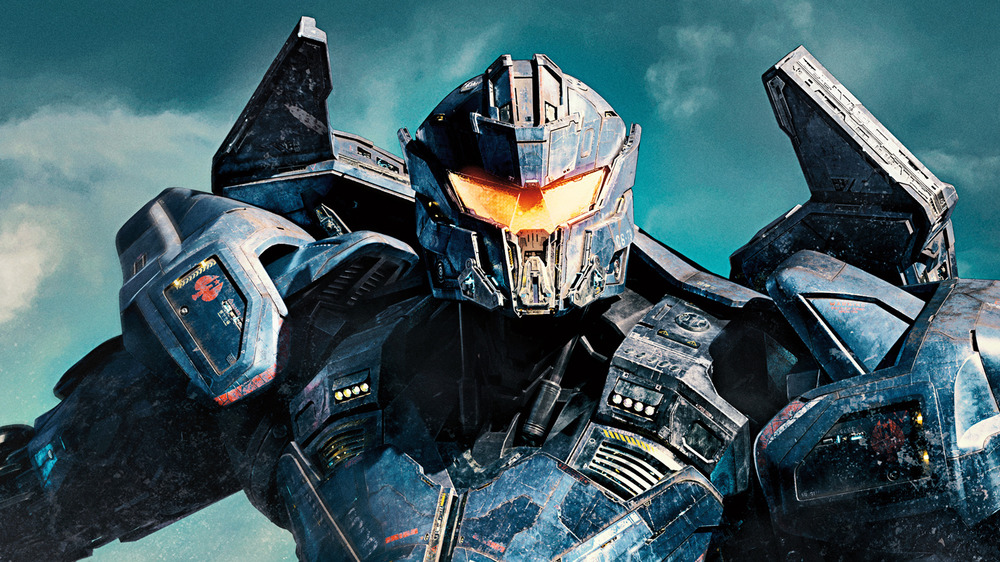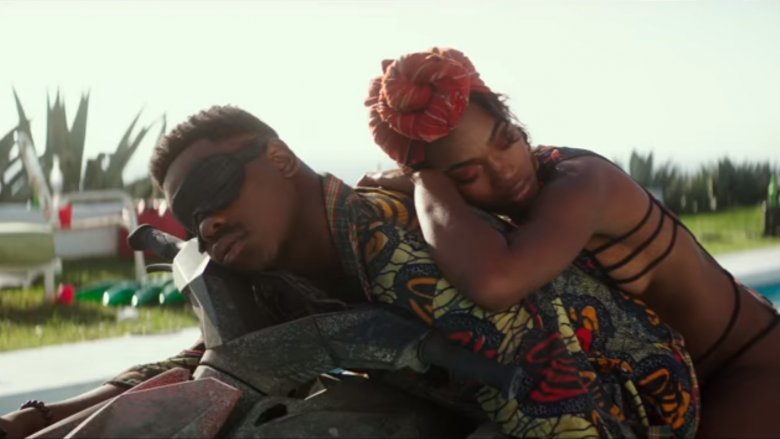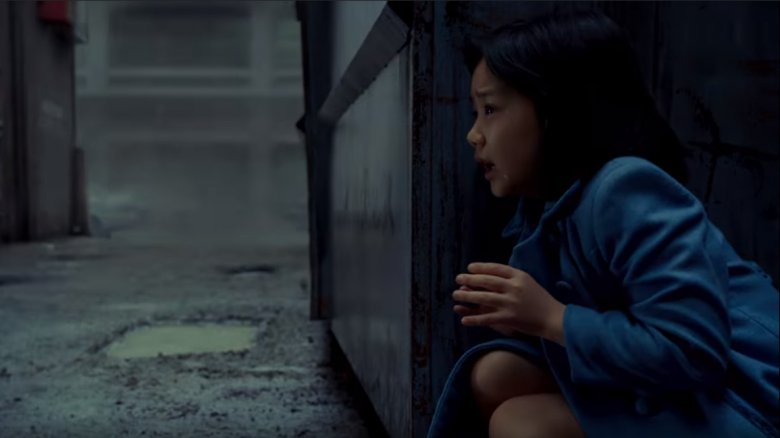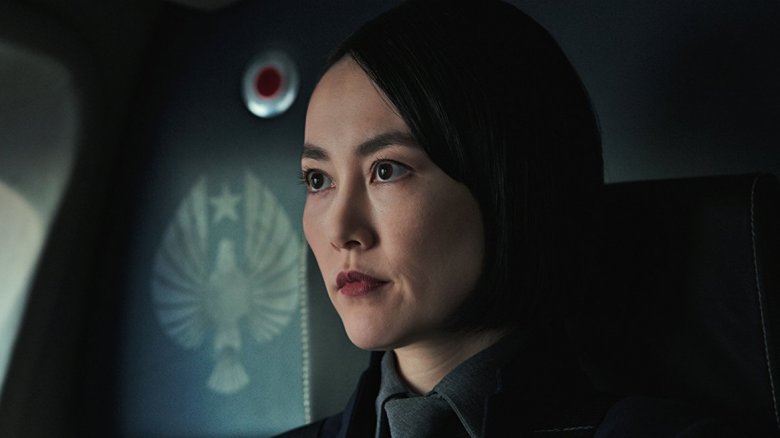Small Details You Missed In Pacific Rim: Uprising
Underneath all the colorful mythology and blockbuster world-building surrounding the story, Pacific Rim: Uprising may be a movie that comes down to the battle between giant robots punching giant monsters, but just like its predecessor, it's a film that takes place on a very, very detailed canvas. With the sequel to Guillermo del Toro's 2013 action extravaganza now in theaters, we're finally getting the chance to unpack all of the new additions to this massive (in so many ways) franchise, from new robot fights to new character backstories and much more.
There's so much detail packed into the two Pacific Rim films that we likely won't find them all until we can sit down and go frame-by-frame with both Blu-rays, but we've definitely seen enough to get a feel for a number of the less obvious details nestled in the frame. Here's a look at the small details you missed in Pacific Rim: Uprising.
Life in a post-kaiju world
Pacific Rim: Uprising picks up a decade after the events of the first film, meaning it's been 10 years since humanity closed the trans-dimensional portal known as "The Breach" and cut off kaiju access to our world. The war between humanity and the kaiju is long over, but its impact is still being felt in all aspects of daily life on Earth, including the economy.
While some places (the gleaming metropolis of Sydney, for example) seem to be thriving, others (like the California coast with its half-smashed mansions) are struggling as they continue to rebuild, creating a hotbed for opportunists looking to make money on the black market. In Pacific Rim, that market was rife with dealers selling off kaiju body parts. By the time Uprising rolls around, it's jaeger parts everyone's after, including Jake Pentecost (John Boyega). When we first meet him, Jake is shameless in his quest to continue funding the party lifestyle that allows him to alive in a ruined beachfront mansion in the shadow of a kaiju skeleton. To do this, he's willing to raid decommissioned jaeger yards for parts, but also to rip off fellow black marketers in the process. Among his past victims: "Chau in Hong Kong," no doubt a reference to notorious kaiju parts dealer Hannibal Chau, played by Ron Perlman in the first film.
Jake is also willing to think smaller to achieve his ends, trading things he's stolen for a few luxuries like Cap'n Crunch cereal, Oreo cookies, and Sriracha hot sauce. What's he willing to give up for such things? Well, in one shot, we get one answer in a small detail — he hands off a shiny statue that looks suspiciously like an Oscar. He did set up shop in a California mansion, after all.
Monsters from the past
The end of the kaiju war may be a decade old, but the memories are still fresh for much of humanity, and not just because of the kaiju skeletons dotting the landscape. Amara Namani (Cailee Spaeny) tells Jake that she built her mini-jaeger Scrapper because she wants to be ready when the kaiju return, and her warehouse hideout is proof of her dedication. Among the memorabilia she has stashed away: countless newspaper clippings documenting the war and a few action figures, including what appears to be the legendary jaeger Gipsy Danger.
She's not the only one still committed to continued study of the kaiju foes of the past. Dr. Hermann Gottlieb (Burn Gorman) still keeps reminders around his lab, including a model of Knifehead, the kaiju that took out Gipsy Danger in the opening minutes of Pacific Rim. The kaiju database Gottlieb calls up in an attempt to decode Mako Mori's (Rinko Kikuchi) last transmission also includes familiar kaiju, including Otachi (one of the kaiju responsible for the "double event" attack in Hong Kong in the first film) and Trespasser, the very first kaiju to reveal itself to humanity.
Deceased kaiju also still play a major role in the training of new jaeger pilots. When she enters the jaeger simulator, Amara goes head-to-head with a familiar, crustacean-like kaiju, only to reveal she has a lot to learn. The monster is code-named "Onibaba," and first appeared in Pacific Rim as the kaiju that terrorized a young Mako before she was rescued by Stacker Pentecost (Idris Elba).
A father's legacy
Among Jake Pentecost's very first lines in Uprising is the statment "I am not my father," but the world won't stop reminding Jake that he's the son of a legend — Stacker Pentecost, the no-nonsense pilot played by Idris Elba in the first film. Though he's been dead for 10 years, the elder Pentecost still casts a long shadow in Uprising. Amara freaks out the moment she hears Jake's last name, news feeds refer to him as Stacker's son when he co-pilots Gipsy Avenger to Sydney, and Stacker's photo holds a place of honor on a memorial wall in the Moyulan Shatterdome. Even Dr. Newton Geiszler (Charlie Day) can't help but recall Stacker's glory days when he meets Jake, referring to the legendary speech in which Stacker implored his fellow soldiers to cancel the apocalypse. It's a lot to live up to — it's no wonder the kid is living such a shiftless life when we first meet him.
The impact of Mako Mori
Stacker was the character who got the great speech at the end of Pacific Rim, but Kikuchi's Mako Mori was the first film's most fully realized character. Stacker's adoptive daughter who lost her family in the early days of the kaiju war, she spent much of the film fighting to prove herself, and to get out into the field and fight for herself. She eventually earned that right, was one of the surviving heroes of the Battle of the Breach, and became the General Secretary of the Pan Pacific Defense Corps. Sadly, her role in Uprising is greatly reduced, but several details give away just how important she was to Jake.
Because Jake isn't in the first film, these details have to be added in small doses, but they make a difference. For example, after Mako's death in Sydney, Jake pulls out a photo of himself, his father, and Mako in happier times. Then, when he begins to teach Amara how to drift in the jaeger simulator, his memories reveal a moment in which Mako trained with him, using the same staff-fighting skills she showed off in the first film. We get very little time with the two of them, but Mako and Jake clearly loved each other.
Fallen heroes
In any war, the conflict is defined by loss as well as victory. Memories of lost loved ones, friends and comrades in arms dominate both installments in the Pacific Rim franchise, from Raleigh Becket's (Charlie Hunnam) memories of his brother in the first film to Jake's loss of Mako in the second. Mako's death in particular is used in Uprising as a moment to mark this impact not just in terms of Jake, but in terms of the world. When he returns to Moyulan, Jake visits the memorial wall where his father and sister are enshrined, but as the shot lingers, we get to see photos of other fallen heroes from the kaiju war. Among them are Sasha (Robert Maillet) and Aleksis (Heather Doerksen) Kaidonovsky, the Russian pilots of the jaeger Cherno Alpha, who were killed during a double kaiju attack off the coast of Hong Kong in 2025.
Where is Raleigh Becket?
While Mako Mori returns for Uprising, having risen through the ranks of the PPDC, the other major surviving hero of the Battle of the Breach is absent. Raleigh Becket, the co-pilot of Gipsy Danger who helped end the kaiju war, appears nowhere in the film, and is only mentioned by name once, during Jake's stirring speech at the end of the movie. Becket's name drop comes alongside Stacker and Mako, but while they're both clearly casualties memorialized by the PPDC, we're never told what became of Becket. He clearly didn't die, because if he had he'd be somewhere on that wall. Did he retire? Did he fall from favor?
According to director Steven S. DeKnight, Pacific Rim star Charlie Hunnam was planning to return for the sequel, but backed out when the film's schedule conflicted with his remake of Papillon. Rather than kill the character off or squeeze in a cameo, the decision was made to live Raleigh's whereabouts ambiguous, just in case Hunnam might want to make a triumphant return for Pacific Rim 3.
Back to where it all began
When moviegoers first entered the world of Pacific Rim, it was to witness the Becket brothers take Gipsy Danger out into the "miracle mile" (the last line of defense between kaiju and populated areas on the coast) to battle the kaiju Knifehead in 2020. That fight destroyed Gipsy Danger (later rebuilt) and killed Yancy Becket, which led Raleigh Becket to leave jaeger piloting behind until he rejoined the fight in 2025.
In 2035, when Uprising takes place, both Gipsy Danger and Raleigh Becket are long gone, but the film does give a little nod in the direction of that opening action sequence. When Shao's (Jing Tian) jaeger drones are taken over by their kaiju implants, one of the places they head to open up new breaches around the Pacific Rim is Anchorage, Alaska, site of the jaeger shatterdome that was Gipsy Danger's original home.
Another giant robot franchise
Pacific Rim is a franchise full of influences from Japanese pop culture, from its various kaiju designs to the legendary mecha series that helped inspire the jaegers. In Uprising, that influence isn't just felt in the designs, but in one very direct reference. During the final battle in Tokyo, Amara is forced to eject from her jaeger and land amid the rubble. As she climbs out of her pod, the camera lingers over a massive robot statue in front of a building, but it's not a jaeger. It's a Gundam, a nod to the Japanese media franchise of the same name that launched with Mobile Suit Gundam back in 1979. Clearly, in the world of Pacific Rim, the idea to build giant robots wasn't just something that arrived as soon as the kaiju did — it was already there, deeply embedded in this alternate world's popular culture.
A familiar site for monsters
When three kaiju make it through the breach sites opened up by the drones, Gottlieb, Shao, Jake, and Nate (Scott Eastwood) are finally able to piece together what's been the master plan of the kaiju and their Precursor masters all along. The kaiju aren't just destroying cities and wreaking havoc. This time they're carving a direct path toward Mt. Fuji, Japan's iconic volcano, where their blood will react with the "rare earth elements" inside and create a reaction that will wipe humanity off the planet and essentially terraform Earth into a perfect Precursor habitat. This sets up a race against time as the remaining jaegers fight to stop the Mega-Kaiju from reaching Mt. Fuji and ending humanity, but it's not the first time giant monsters have battled for the fate of the world there. As one of Japan's most recognizable landmarks, Mt. Fuji has played host to a number of kaiju battles throughout the history of Japanese monster cinema, appearing in classics ranging from King Kong vs. Godzilla (1962) to Ghidorah, the Three-Headed Monster (1964) to Godzilla: Final Wars (2004).



